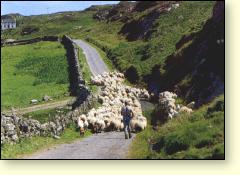


Island of Islay
Islay is the southernmost of the whisky-producing islands of the Inner Hebrides. It lies to the west of the Kintyre peninsula. There are both Celtic and Norse strains to Islay’s history and in the 12th century Somerled, King of Argyll, made Islay his capital, founded the Clan Macdonald and set up the rule of the Lords of the Isles which lasted for 300 years.
The island has fine sheep and cattle pasture and the fertile soil yields fine barley. The landscape is padded with many peat-bogs and the cuttings from them have provided life-giving heat to the islanders over long centuries. It is completely odourless in its natural state, but, when burned, it has a rich and pungent smell. Peat is a community asset on Islay and local inhabitants are permitted to dig their own as a fuel supply from certain mosses for a nominal payment of £10 a year.
The incidence of peat and the proximity of the distilleries to the sea are the main circumstances that make Islay a category in its own right in the classification of Scotch whisky. Peat and salty seaspray impart the bold aroma and flavour that are the prevailing keynotes which typify the category. Peat saturates the fine, soft water used for distillation and smoky heat dries the malted barley. Salt and seashore aromas are absorbed by the moist air that surrounds the casks of maturing spirit. Small wonder, then, that such influences show through generously in the whisky.
Other islands had their distilleries which vanished when it became easier to take supplies from outside the community, but not so on Islay. Its makes are so powerful and individual that they just couldn’t be let go. Islay malts are the heart, the core, the engine-room (with Rolls Royce machinery, of course) of most Scotch blends and the full-throated single malts are widely favoured.
Malt whisky is the original, ubiquitous Scotch whisky and Islay malts were always in demand. However, a shift to blends of malt and grain whiskies signalled consumer interest in lighter products. From the tail-end of the 19th century, Islay was more in demand as a blending component than as individual self whiskies.
The relative isolation of Islay has meant the retention of many traditional routines and equipment. Three of the few hand-turned malting floors left in Scottish distilleries are to be found on Islay at Bowmore, Laphroaig and Ardbeg, although the latter is now closed and for sale.
Laphroaig Distillery
Lagavulin Distillery
Bowmore Distillery
Bruichladdich Distillery
Caol Ila Distillery
Bunnahabhain Distillery